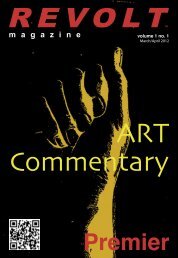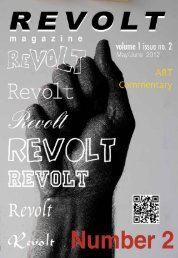Download PDF Version Revolt Magazine, Volume 1 Issue No.4
Download PDF Version Revolt Magazine, Volume 1 Issue No.4
Download PDF Version Revolt Magazine, Volume 1 Issue No.4
You also want an ePaper? Increase the reach of your titles
YUMPU automatically turns print PDFs into web optimized ePapers that Google loves.
BETWEEN DESTINATIONS:<br />
THE ROSE<br />
UNEARTHED<br />
BY RANDEE SILV<br />
After circling through the 4th floor galleries at the<br />
Whitney Museum, I found myself returning to the<br />
same exact spot at Jay DeFeo: A Retrospective<br />
(February 28 - June 2, 2013). It was like being<br />
caught in a visual net as my glance slightly turned<br />
in both directions. I couldn’t move as I stood there<br />
between DeFeo’s seven foot wide hypnotic graphite<br />
on paper, The Eyes (1958), and the monumental,<br />
nearly one ton, The Rose (1958-66), nestled<br />
in the small sanctuary that the museum had<br />
designed to emulate the sunlight as it streamed<br />
into her Fillmore Street studio. DeFeo always felt<br />
that this drawing had something of a “prophetic<br />
or visionary meaning,” and it was through these<br />
eyes that her works to come would be envisioned.<br />
Her desire was that some day these two pieces<br />
would be shown together. I could almost hear them<br />
conversing. Unexpectedly, I was drawn in.<br />
Jay DeFeo was a painter among the ‘50s San<br />
Francisco scene of artists, poets and jazz<br />
musicians. After graduating from the University of<br />
California at Berkeley with a master’s degree, she<br />
was awarded a traveling fellowship that no woman<br />
had yet received. Knowing this, the art department<br />
strategically recommended her as J. DeFeo. She<br />
then spent a year and a half in Europe and North<br />
Africa before settling in Florence for 6 months.<br />
Intrigued by ordinary objects, astronomy, unspoken<br />
subjects, erasures, Italian architecture, jagged<br />
mountain peaks, Asian, African & prehistoric art,<br />
DeFeo dynamically meshes her own rhythms and<br />
forms.<br />
Dorothy Miller, the curator and director of the<br />
Museum of Modern Art, who happened to be out<br />
talent scouting, saw DeFeo’s first one-person<br />
show at the Dilexi Gallery in San Francisco. Miller<br />
visited DeFeo’s studio and was hoping to include<br />
The Rose (entitled Deathrose at that time) in the<br />
upcoming 1959 landmark exhibition, Sixteen<br />
Americans (December 16, 1959 - February 17,<br />
1960). Holding out for a showing on the West<br />
Coast, DeFeo hesitated about parting with her<br />
work still in progress. Five other pieces were<br />
chosen, and a reproduction of the unfinished<br />
Deathrose was published in the accompanying<br />
catalogue. DeFeo and her husband, Wally<br />
Hendricks, decided to turn down the plane tickets<br />
bought by MoMA for the opening. Hendricks, who<br />
was also invited to be in the exhibition, was known<br />
for his kinetic assemblages and was co-founder<br />
of The Six Gallery, an underground art gallery and<br />
hang for Beat poets.<br />
“Wally and I didn’t really realize the stature and the<br />
prestige of being included in such a show. I was<br />
really unaware of the situation. It surprises many<br />
people that we were the only people included<br />
in the show who didn’t make the effort to go<br />
back for the opening. The whole show was kind<br />
of a coming-out party, I discovered later. It was<br />
intended to be for galleries in search of new talent.<br />
I was approached by the Stable Gallery through<br />
correspondence, which I turned down.”<br />
New York Times critic, John Canaday wrote “For my<br />
money, these are the sixteen artists most slated for<br />
oblivion.” Included in the show were Jasper Johns,<br />
Robert Rauschenberg, Louise Nevelson, Ellsworth<br />
Kelly and Frank Stella.<br />
Having found herself on an unplanned journey that<br />
engulfed and obsessed her for eight years, DeFeo<br />
devoted herself intensely to painting, layering,<br />
sculpting, working and reworking Deathrose.<br />
She repeatedly applied thick coats of white oil<br />
paint, using black to minimize the yellowing and<br />
occasionally mixing in mica for sparkle, while<br />
scraping, reapplying, working with thinness and<br />
thickness, allowing paint to dry and carving into<br />
the material with a palette knife. Extending the<br />
painting’s radiating lines from a study photograph<br />
in preparation to enlarge Deathrose, she drew<br />
and painted these extensions directly onto the<br />
supporting wall around the canvas, later removing<br />
her work from its stretcher bars, gluing it to a<br />
larger unprimed canvas and placing it in her front<br />
room bay window. More pigment was intuitively<br />
placed, reformatting the center, shaping hard<br />
edged grooves into smooth ridges and crevasses<br />
highlighting the sun’s rays, emphasizing shadows,<br />
observing proportions, contours, growing thicker<br />
and heavier with each stage as unpredicted<br />
surface textures kept emerging.<br />
Deathrose was extensively photographed in its<br />
many evolving phases. Images circulated even<br />
before its completion. One landed in a 1961<br />
Art in America article, “New Talent U.S.A.” That<br />
same year, the travel magazine Holiday included<br />
Deathrose in a piece “San Francisco: The<br />
Rebels.” DeFeo was the only painter mentioned<br />
and described as “one of San Francisco’s most<br />
successful younger artists.” The photograph of<br />
DeFeo working on Deathrose as she stood on a<br />
stepladder appeared in a 1962 issue of Look.<br />
News of her mammoth sculptured painting began<br />
spreading. Different institutions were thinking<br />
about how they might acquire Deathrose, but<br />
DeFeo had no intention of donating her work.<br />
DeFeo working on what was then titled Deathrose, 1960. Photograph<br />
by Burt Glinn. © Burt Glinn/Magnum Photos.<br />
In 1965, DeFeo and Hendricks ended up being<br />
evicted from their Fillmore studio when the building<br />
was condemned and new owners doubled the rent.<br />
Deathrose measured nearly 12’ x 8’ with depths in<br />
spots deeper than eight inches and had to be cut<br />
away from the studio wall, a crate built around it,<br />
lowered by forklift to a truck below and relocated<br />
to a small room for storage at the Pasadena Art<br />
Museum.<br />
Bruce Conner, friend, filmmaker, interdisciplinary<br />
REVOLT <strong>Magazine</strong> Number 4, 2013 8





